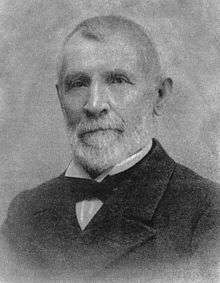John Means (politician)
| John Means | |
|---|---|
 | |
| 2nd Mayor of Ashland, Kentucky | |
|
In office October 20, 1881 – June 7, 1882 | |
| Preceded by | H. B. Brodess |
| Succeeded by | William Wirt Culbertson |
| Personal details | |
| Born |
September 21, 1829 West Union, Ohio, United States |
| Died |
February 14, 1910 (aged 80) Ashland, Kentucky, United States |
| Spouse(s) | Henrietta Perkins |
| Children | Ellison Cooke and Eliza Isabelle Means |
| Parents | Thomas and Sarah (Ellison) Means |
| Residence | Ashland, Kentucky, United States |
John Means (September 21, 1829 – February 14, 1910)[1] was a mayor of Ashland, Kentucky and leader in business affairs. Before that he was a cashier of the Bank of Ashland, which had been founded by his father and uncle. He organized the Cincinnati and Big Sandy Packet Company, and laid out Ashland Cemetery.[2]
Biography
John was born to Sara Ellison and Thomas W. Means of North Carolina, a settler of Hanging Rock, Ohio. Through his paternal great-great-grandmother, he was a relative of Isaac Newton. In his youth, his uncle Hugh often worked with his father, Thomas. Thomas built the Buena Vista Furnace in Kentucky, with Hugh as a stockholder, and, in 1856, the Means brothers became directors of the Kentucky Iron, Coal & Manufacturing Company. That spring, they helped organize the Bank of Ashland, and John became cashier, serving as such from 1866 to 1869.
In 1856 he helped his father and uncle begin the Cincinnati and Big Sandy Packet Company, starting with one boat, called the Scioto, but soon expanding all the large freighters in the iron region. The Means were responsible also for initiating the ferryboat service in Ashland, Kentucky.
John Means was married to Mrs. Harriet Perkins of Marietta, Ohio on October 25, 1854.
John bought the land for and laid out Ashland Cemetery, and was a trustee of the graveyard for many years. In 1860, he was elected a trustee of the Town of Ashland, serving several years in that capacity. In 1869 he was instrumental in organizing the Eastern Division of the Lexington & Big Sandy Railroad Company, and in 1870 was elected president of it. The Ashland Furnace Company was owned by the railroad, the furnace being built under John's supervision. When completed, it was the largest in the United States. John's two daughters had the honor of "firing" it for the first time on August 30, 1869.
When the Ashland Bank dissolved in 1872, and its directors instead organized the Ashland National Bank. With Hugh Means as president, John served as vice-president.
In 1874 Means was a candidate for United States Representative of Kentucky.[3] John Means helped organize in 1864 the Ashland Coal Company and also the Hanging Rock Iron & Coal Company. In 1864, the Princess Furnace, about ten miles from Ashland and on the L. & B. S., was put into operation.
Notes and references
- ↑ History of Kentucky and Kentuckians
- ↑ A History of Ashland, Kentucky 1786 - 1954
- ↑ John Means - Political Cemetery